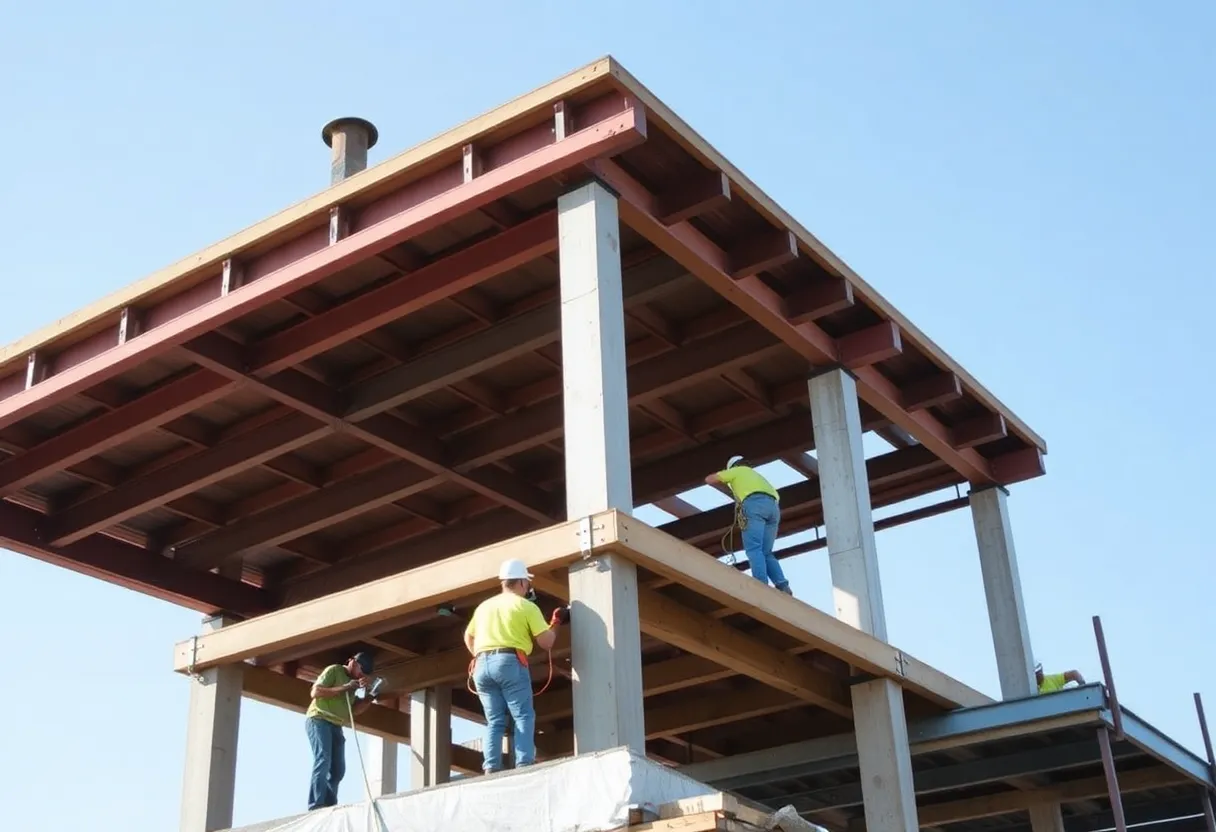United States, August 18, 2025
News Summary
A Fed policy easing and bond‑market moves have pushed mortgage pricing toward the mid‑6% range, with mortgage pricing stabilizing near 6.58% and the 10‑year Treasury around 4.29%. The bond backdrop means rates may not fall much further without clearer economic weakness. Builders are responding with record buyer incentives and a shift to asset‑light land strategies to preserve volume, while large strategic capital allocations into steel and homebuilding signal continued structural demand. Commercial real estate shows mixed signals: multifamily absorption is strong, offices face high vacancies, and logistics remain attractive for investors focused on Sunbelt corridors.
U.S. housing market hits an inflection point after September 2025 Fed cut; mortgage rates stabilize near mid‑6%
Top line: A late‑September 2025 Federal Reserve rate cut of 25 basis points and recent moves in the bond market have pushed mortgage rates toward the mid‑6% area. Mortgage pricing stabilized near 6.58% in late August 2025, while 10‑year Treasury yields settled around 4.29%, keeping mortgages more sensitive to Treasury behavior than to the federal funds rate. In parallel, large strategic investments into steel and homebuilding stocks, and a major builder pivoting to an asset‑light model with heavy buyer incentives, are reshaping near‑term supply, demand and investor strategy across residential and commercial real estate.
Why this matters now
The bond market had priced a high probability of a Fed cut well before September, and that policy move has removed some near‑term upside for mortgage rates. Still, the behavior of the 10‑year Treasury suggests mortgage rates are unlikely to fall below roughly 6.3% without clearer evidence of economic slowing. The breach of the psychological 6.5% mortgage threshold has already shifted buyer sentiment, and builders and lenders are reacting with incentives and pricing changes to keep sales moving.
Builders, capital and a big name investor
Major capital allocations into construction‑related companies underline a view that structural demand for housing and infrastructure remains intact. One prominent investor acquired stakes totaling hundreds of millions in a steelmaker and leading homebuilders, and also maintains a very large cash war chest of about $344 billion to deploy when dislocations appear. These purchases were framed as a bet on long‑term structural demand for homes, manufactured housing and construction materials.
Lennar’s strategic pivot: land‑light model, leadership changes and bigger incentives
America’s second‑largest homebuilder has accelerated an asset‑light approach that now controls about 98% of lot positions via land option contracts and spun a property arm into a separate REIT to trim balance‑sheet risk. Senior leadership changes included the retirement of a long‑time COO and a general counsel, with a new chief legal officer appointed from outside the industry. The retiring COO will serve as a consultant while the company moves forward without a direct COO replacement, signaling an emphasis on operational agility over traditional hierarchical structure.
To maintain sales volume amid a slow spring 2025 selling season, the builder increased buyer incentives substantially. Incentive spending ran at about 13.3% of final sale price in Q2 2025 — the highest level seen since 2009 by third‑party research — and management said normalized incentive levels would typically be near 5–6%. The builder also completed a purchase that added roughly 5,000 homes in affordability‑focused Sunbelt markets, with an average sales price of about $230,000 on those acquisitions.
Financial posture and operating metrics
After a spin‑off, the homebuilder reported a cash balance of about $4.7 billion and a conservative debt‑to‑capital ratio near 7.5%. The company completed sizable share repurchases in prior periods and showed inventory turnover improving to 1.7x. Gross margins have come under pressure, with Q1 2025 at 18.7%, Q2 at 17.8%, and guidance near 18.0% for Q3, while average sales price net of incentives fell to roughly $389,000 in Q2 2025, down nearly 9% year‑over‑year.
Market backdrop: supply, policy and technology
The U.S. faces a persistent housing shortfall estimated between 5.5 and 6.8 million homes. At the same time, federal infrastructure and clean‑energy programs plus semiconductor and advanced manufacturing incentives have injected roughly $1.9 trillion in project demand, boosting construction needs for roads, power and industrial facilities. Technological advances — including AI, robotics and Building Information Modeling — are helping offset labor limits and raising productivity in construction. Examples of tech adoption include automation and scrap recycling at major steelmakers, which can improve cost and environmental profiles.
Commercial real estate snapshot
Office deal activity ticked up about 30% in Q2 2025, but vacancies remain elevated at roughly 14.1% and rent growth in the office sector is slowing. Multifamily has shown more defensive characteristics, with positive absorption and stable vacancy metrics, while industrial vacancy climbed to about 7.3% and is softening. Investors are advised to favor high‑absorption multifamily and logistics assets in Sunbelt and key distribution corridors, and to avoid overleveraged office assets facing vacancy‑driven re‑pricing.
Investor opportunities and caution
Three strategic opportunities stand out in the current environment: 1) residential positions in markets where inventory is normalizing and builders are using price concessions, especially in Sunbelt regions; 2) construction and industrial plays — including steelmakers, large homebuilders and infrastructure‑exposed firms — to ride policy‑driven demand and capital endorsements; and 3) commercial real estate bets on high‑absorption multifamily and logistics assets while avoiding stressed office properties. Diversification and liquidity remain critical risk mitigants, illustrated by large corporate cash reserves positioned to buy assets during market dislocations.
Local market signals
Unsold completed new single‑family homes rose markedly through early 2025, with counts reaching levels not seen since the depths of the last major downturn. Several Sunbelt and Gulf markets show elevated unsold and active resale inventory, creating downward pressure on prices and more incentive-driven selling for builders operating in those regions. Markets tied to the pandemic boom have seen the sharpest shifts in resale activity and builder inventory.
Bottom line
Policy easing in September 2025 reduced some rate risk, but mortgage pricing remains anchored by Treasury yields, keeping rates in a mid‑6% range for now. Builders are choosing volume over margin in many markets, using record incentive levels to keep sales flowing, while long‑term structural drivers and federal infrastructure spending continue to support construction demand. For investors and industry participants, the near term is about managing incentives, maintaining liquidity and targeting areas where absorption and fundamentals remain strong.
Frequently Asked Questions
Q: Did the Fed cut rates and will that lower mortgage rates significantly?
A: The Fed cut rates by 25 basis points in September 2025, which eased policy costs, but mortgage rates are more sensitive to the 10‑year Treasury yield. With the 10‑year near 4.29%, mortgages may remain in the mid‑6% area unless bond yields fall further on clear signs of economic weakening.
Q: Why are builders offering larger incentives?
A: Builders face a slow season and higher unsold inventory in many markets. To preserve sales volume, several have raised incentives — mortgage buydowns, price reductions and closing cost help — leading to incentive spending well above pre‑pandemic norms.
Q: What does a land‑light strategy mean for a homebuilder?
A: A land‑light approach relies on option contracts and alternative lot control methods rather than owning large land portfolios outright, reducing balance‑sheet risk and allowing more capital flexibility.
Q: Where are investors finding opportunity in commercial real estate?
A: Investors are focusing on multifamily (high absorption) and logistics/industrial properties in growing Sunbelt and corridor markets, and steering clear of overleveraged office assets with high vacancy.
Key features at a glance
| Feature | Key figure or note |
|---|---|
| Fed action | 25 bps cut — September 2025 |
| Mortgage rate (late Aug 2025) | 6.58% (stable in mid‑6% range) |
| 10‑year Treasury yield | ~4.29% |
| Housing shortfall | Estimated 5.5–6.8 million homes |
| Builder incentives (Q2 2025) | ~13.3% of final sales price |
| Homebuilder cash balance | ~$4.7 billion (post spin‑off) |
| Commercial vacancies | Office 14.1% | Industrial 7.3% (rising) | Multifamily defensive |
| Strategic investor cash | ~$344 billion held in reserve (Q2 2025) |
Deeper Dive: News & Info About This Topic
Additional Resources
- Finimize: Lennar asset snapshot
- Wikipedia: Housing in the United States
- Ainvest: Lennar leadership transition
- Google Search: Lennar Corporation
- Seeking Alpha: Declining Sun‑Belt affordability
- Google Scholar: Sunbelt housing affordability 2025
- Fast Company: Florida & Texas housing market / Lennar incentives
- Encyclopedia Britannica: Housing market
- ResiClub Analytics: Unsold inventory hits 15‑year high
- Google News: Unsold new single‑family homes 2025
Author: Construction FL News
The FLORIDA STAFF WRITER represents the experienced team at constructionflnews.com, your go-to source for actionable local news and information in Florida and beyond. Specializing in "news you can use," we cover essential topics like product reviews for personal and business needs, local business directories, politics, real estate trends, neighborhood insights, and state news affecting the area—with deep expertise drawn from years of dedicated reporting and strong community input, including local press releases and business updates. We deliver top reporting on high-value events such as the Florida Build Expo, major infrastructure projects, and advancements in construction technology showcases. Our coverage extends to key organizations like the Associated Builders and Contractors of Florida and the Florida Home Builders Association, plus leading businesses in construction and legal services that power the local economy such as CMiC Global and Shutts & Bowen LLP. As part of the broader network, including constructioncanews.com, constructionnynews.com, and constructiontxnews.com, we provide comprehensive, credible insights into the dynamic construction landscape across multiple states.





